Navigating the Richness of Traditional Souks
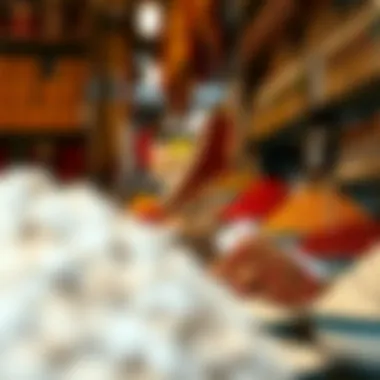

Intro
In an age where supermarkets dominate the retail landscape, the allure of traditional souks remains as compelling as ever. Navigating these bustling markets provides a glimpse into the cultural and economic heart of communities, particularly in urban areas across the globe. Souks are not merely places to shop; they are vibrant ecosystems that embody the rich history and traditions of the regions they inhabit. This guide offers a detailed exploration of these markets, shedding light on their significance, shopping experiences, and the art of bargaining within their lively confines.
From the fragrant spices of Marrakech to the intricate handicrafts in Istanbul, souks serve a multifaceted role beyond mere commerce. They are crucial for local economies, often sustaining small businesses and promoting artisan craftsmanship. They also foster community connections, turning casual shoppers into familiar faces over time. In this exploration, we will delve further into the historical roots and contemporary relevance of these marketplaces, weaving together stories of past and present.
With a closer look, we aim to showcase the unique charm of souks while highlighting how they adapt to modern challenges. Expect to unearth practical insights on how to navigate these markets effectively, ensuring that your shopping experience is not just enjoyable but also memorable.
As we embark on this journey through local markets, let’s also take a moment to appreciate the dynamics of local commerce and community interaction. By understanding the nuances and the traditions that underscore these marketplaces, we begin to grasp their indispensable role in our changing world.
If you have ever felt lost in a foreign market or simply want to understand the lively buzz of a souk, this guide is your passport to uncovering the soul of local commerce.
Preface to Traditional Souks
Traditional souks hold a special place in the heart of local communities, functioning as vibrant marketplaces that connect people, culture, and commerce. These bustling hubs of activity are not merely places for purchasing goods; they embody the essence of a community's identity and history. In this article, we aim to delve deeper into the intricate tapestry of souks, showcasing their significance beyond simple transactions.
Definition and Overview
At its core, a souk refers to a market or bazaar, often characterized by a labyrinth of narrow lanes bustling with vendors offering an array of goods. Souks are richly diverse, ranging from the spice markets of Marrakech to the craft-filled stalls of Istanbul. Each souk reflects the unique heritage and local flavors of its region, making them hotspots for experiencing authentic culture.
These markets typically present a vibrant display of colors, smells, and sounds. You'll find artisans crafting intricate wares alongside merchants hawking everything from spices to textiles. Just walking through a souk, one can absorb the energy of the community, feeling the heartbeat of a culture that has thrived for generations.
In a world increasingly dominated by online shopping and retail chains, traditional souks offer a refreshing, more personal experience. Shoppers can engage with local artisans directly, learning about their goods and the stories behind them. This interaction fosters a sense of community and supports local economies, making souks vital to preserving cultural heritage.
Historical Significance
Since ancient times, souks have been integral to local trade networks. They served as gathering spaces for merchants and travelers, facilitating exchange not just of goods, but of ideas and culture. Historically, notable souks were often positioned along major trade routes, allowing them to flourish as centers of commerce.
For instance, the Souk Al-Mubarakiya in Kuwait City can trace its roots back more than a century, reflecting the city’s transformation and adaptability over time. Here, the historical context intertwines with contemporary life, offering visitors a glimpse into the city's evolution while preserving traditional practices.
The archaeological importance of souks cannot be overstated; many still feature ancient architecture, a living testimony to their storied past. Each alley and shop tells a tale, a narrative woven into the fabric of everyday life, representing the shared experiences of countless generations. This rich history accounts for the loyal patronage of souks, drawing not just locals, but tourists eager to experience an authentic slice of culture.
In summary, traditional souks are more than mere shopping destinations. They are historical landmarks and cultural emblems, deeply ingrained in the identity of the communities that house them. As we proceed through this guide, we will explore their cultural importance, economic significance, and relevance in today’s rapidly changing world.
Cultural Importance of Souks
Understanding the cultural significance of souks is essential for grasping their role within local communities. These bustling markets are not just places to shop; they are vibrant hubs where culture, heritage, and community converg. Souks serve as living museums, showcasing the craftsmanship, traditions, and values that define the identity of the people. Their preservation and continued relevance highlight the fusion of the past and present, creating a tapestry of experiences that benefit both locals and visitors alike.
Cultural Heritage and Community Identity
Every souk tells a story, weaving together the threads of history, community identity, and cultural heritage. For many, these marketplaces represent a sense of belonging, amplified by the shared experiences of bargaining for spices, textiles, or handcrafted goods. In places like the Marrakech souk in Morocco, the aroma of saffron mingles with the chatter of vendors, each stall echoing tales of centuries gone by.
Locals often view such markets as embodying their identity. A visit to a souk extends beyond shopping; it’s an invitation to engage with traditional customs, participate in long-standing rituals, and witness the artistry of local artisans. This is particularly important for expatriates or newcomers looking to connect with the community. By stepping into a souk, they are stepping into a community’s heart—an embodiment of its culture.
Souks stand as a testament to resilience against the tide of modernity. In a rapidly changing world, these markets provide a sanctuary where traditions can thrive amid globalization. This is not just about maintaining a way of life; it's about celebrating the unique qualities that set one community apart from another, reinforcing cultural pride.
Role in Preserving Traditions
Souks play a pivotal role in preserving culinary and craft traditions that might otherwise be lost. Elder artisans often pass down their skills to younger generations right in the very same locations where they acquired them. Imagine watching a skilled weaver at work, his fingers deftly moving through strands of colorful thread, while sharing stories that bring the fabric to life.
This transmission of knowledge goes beyond simple transactions; it fosters mentorship and intergenerational dialogue. Young people learn not only the techniques of their craft but also the value of the heritage behind it. Moreover, this exchange of wisdom reinforces community ties, binding generations together through shared purpose and identity.
As consumers increasingly seek authentic experiences, the focus on traditional methods and locally sourced goods becomes more enticing. The rising interest in sustainability dovetails with the practices upheld in souks, often favoring environmentally conscious production methods that honor age-old techniques. For instance, traditional pottery made in the souks often reflects ecological approaches that emphasize quality and durability over mass production.
This intertwining of cultural preservation with modern market demand not only aids in keeping traditions alive, but it also enriches the souk experience for everyone involved.
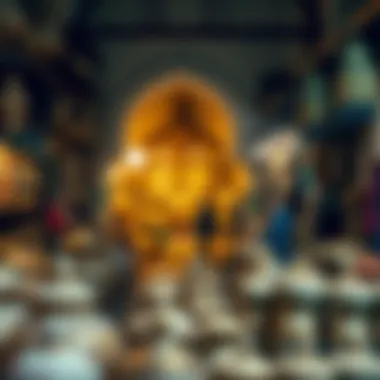

In summary, the cultural importance of souks transcends mere commerce; it embodies community identity and ensures the survival of cherished traditions. As communities evolve, souks remain steadfast, acting as anchors to the past while navigating the currents of the future. For investors and developers interested in the dynamics of local economies, understanding this cultural framework is crucial, not only for profit but for fostering authentic community relationships.
Economic Impact of Souks
Traditional souks are more than just markets; they serve as vital economic engines in their respective localities. Their significance can’t be overstated, as they inject vitality into the local economies, foster entrepreneurship, and provide sustainable income for countless families. Whether you are a local resident or a traveler, understanding the economic impact of these markets sheds light on their role in shaping not just commerce, but community life itself.
Contribution to Local Economies
Local economies thrive on the vibrant interactions that occur within souks. These markets contribute to the economy in various ways:
- Job Creation: Souks are hubs of employment, ranging from artisans selling handmade crafts to vendors offering food and local produce. This diverse ecosystem generates numerous jobs, often providing opportunities for people who might otherwise struggle to find employment.
- Revenue Generation: Visitors flock to souks not only for the unique goods but also for the rich cultural experience. This influx of shoppers results in significant revenue for local businesses and municipalities.
- Economic Resilience: During times of economic downturn, souks often show remarkable resilience. They adapt to new conditions by evolving their products and services, helping local economies weather financial storms.
Souks embody a spirit of community and local pride; they are reflections of the cultures surrounding them. The intertwining of commerce and culture draws in not only local buyers but tourists who wish to take a piece of that culture home. This phenomenon isn’t just a transaction; it is a tapestry of experiences that showcases the locality’s heritage.
Small Business Development
The very nature of souks is conducive to small business development. Many entrepreneurs start their journey in these bustling markets:
- Low Entry Barriers: Setting up a stall in a souk often comes with lower costs compared to conventional retail spaces. This accessibility allows individuals with limited resources to pursue their business dreams.
- Diversity of Offerings: The variety of goods offered promotes niche markets, allowing small business owners to thrive by specializing in areas such as bespoke crafts, artisanal foods, or handcrafted jewelry. This specialization can lead to loyal customer bases.
- Networking Opportunities: Souks foster a unique environment for collaboration among small business owners. The close-knit nature of these markets enables vendors to share knowledge, resources, and even customer referrals, helping each other grow.
As we can see, souks fulfill a multifaceted role in fostering entrepreneurship. They not only give rise to small businesses but also elevate local economies, ensuring that the community thrives. Supporting these marketplaces ultimately contributes to their sustainability and growth.
Navigating the Souk Experience
Navigating a souk is akin to wandering through a living tapestry, where every corner turned reveals a story, culture, and vibrant marketplace interconnected with local life. Understanding the nuances of this experience is essential, especially for those looking to delve deeper into the social and economic fabric of the community. This experience is not just about shopping; it embodies tradition, artistry, and human connection.
Typical Layout and Structure
At first glance, the layout of a souk might appear chaotic, but there are often underlying principles guiding its structure. Each souk is a labyrinth of narrow alleyways and bustling pathways that host countless stalls and shops, often organized by the type of goods sold.
In old Medina of Marrakech, for instance, you'll find the spice souk positioned close to the textile markets, each section uniquely reflecting the crafts that have flourished in specific locations for generations. This structure encourages exploration, as one finds themselves drifting from textiles to spices, to handcrafted pottery—all while absorbing the rich aromas and lively sounds of trade. The layout promotes interaction; the close proximity of different vendors often leads to chance encounters and hidden gems.
- Pathways: Designed for foot traffic, allowing for intimate interactions between customers and vendors.
- Display: Each stall often holds a miniature gallery of the seller's best work, enticing passersby with vivid colors and intricate designs.
- Signage: Simplistic in style, often hand-painted, reflecting the artistry of the region.
Familiarizing oneself with this layout not only eases navigation but also enhances the overall experience, allowing one to appreciate the artistry involved in each traditional craft.
Bargaining Culture
Bargaining is more than just a means to lower prices; it’s an art form that adds depth to the souk experience. The haggling process is typically lively, underscored by playful banter and strategically timed silences. Understanding this culture is crucial for anyone stepping into a souk, especially for newcomers.
An effective approach to bargaining involves establishing rapport with the seller. A warm smile or a few words in the local language can go a long way. Buyers might start with a lower offer—often around half of the asking price—and rise gradually while maintaining a friendly demeanor. This back-and-forth is not only expected but enjoyed by many vendors as they see it like a dance:
- Start Low: As mentioned, begin with a lower offer to set the stage.
- Be Playful: Don’t hesitate to playfully compliment the item or feign disinterest. This can work wonders.
- Know When to Walk Away: Showing you’re willing to leave can often bring the seller back to you with better offers.
"Bargaining is not just about the price, it’s about the experience of commerce as community and connection."
Networking Opportunities
In many ways, souks serve as community hubs where not just buyers and sellers but a diverse array of individuals come together. For investors, expatriates, or developers, these markets represent a wealth of networking opportunities often overlooked.
Establishing relationships in a souk can lead to valuable insights into the local economy, consumer preferences, and emerging trends. Engaging in casual conversation with vendors can yield information on upcoming market shifts or popular products among locals. Additionally, many artisans are happy to share their stories, which can provide deeper connections and possibly open doors for collaborations.
- Attend Local Events: Many souks host events or festivals that can serve as great networking opportunities.
- Follow Local Trends: Pay attention to popular items and shifts in customer behavior through ongoing engagement with local sellers.
- Build Rapport: Invest time in developing genuine relationships. It’s not just business; it’s community.
Ultimately, connecting with individuals in the souk may offer insights that are invaluable to anyone looking to forge a path in local commerce.
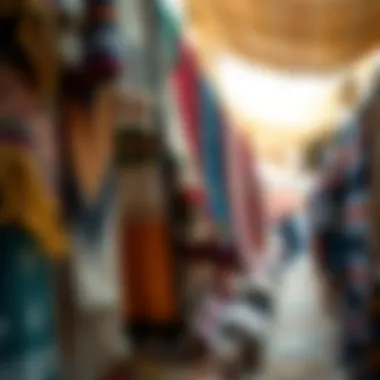
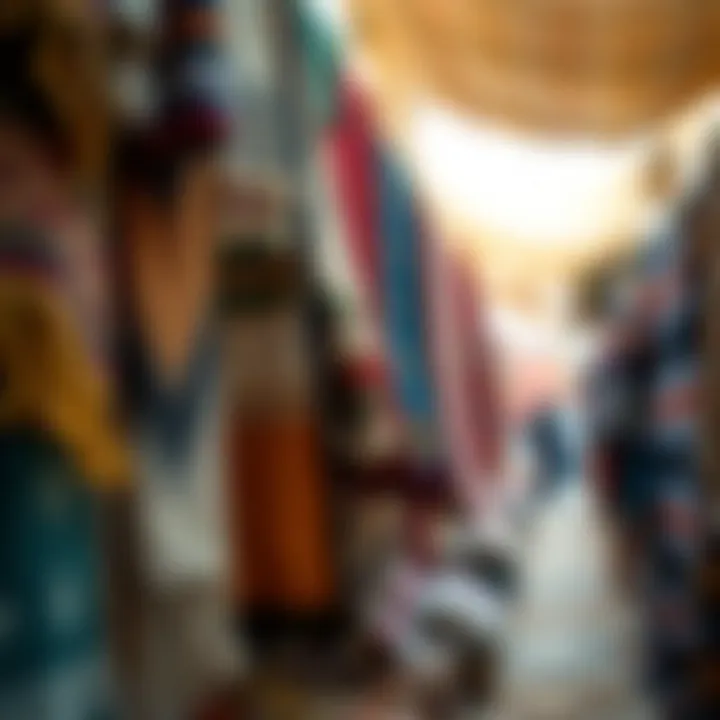
Varieties of Goods Offered in Souks
Exploring the diverse array of goods available in souks is a vital part of understanding their role in local commerce and cultural heritage. Traditional souks serve as vibrant marketplaces where locals and visitors alike can find a rich tapestry of products unique to their regions. The presence of various goods not only attracts customers but also helps preserve artisanal skills and traditions passed down through generations. This eclectic mix of offerings fosters a sense of community and connects people to their roots and each other.
Traditional Crafts and Artisanship
In many souks, the stalls are alive with the sounds of hammers tapping against metal, the soft rumble of clay pots being shaped, or the pleasant brush of a paintbrush on wood. Traditional crafts are a cornerstone of many marketplaces, showcasing local artisan talent. From handwoven baskets to intricately designed pottery, these products reflect the cultural identity of their makers. Each piece often tells a story, embodying techniques that have stood the test of time.
Moreover, the craftsmanship involved in creating these items is frequently a labor of love. Many artisans dedicate years to refining their skills, and the results are visible in the quality of their work. Purchasing these goods not just serves an economic function but also empowers craftspeople and supports the preservation of these time-honored traditions. With every intricate design, there’s a glimpse into the artful past of the community.
Culinary Delights
Stepping into a souk isn't merely about shopping; it’s a sensory experience. One cannot overlook the culinary delights that await around every corner. Stalls overflow with fresh fruits, spices, and baked goods that entice passersby. The aromatic spices—like saffron, turmeric, and cumin—tell a story of culinary traditions that span centuries. Local vendors often share their secrets, allowing visitors to appreciate the rich flavors their dishes bring.
Additionally, many souks feature food stalls that provide a taste of the local cuisine. Delicacies such as falafel, shawarma, or tangy kebabs are not only affordable but also a gastronomic exploration for those willing to step off the beaten path. Food truly enhances the marketplace atmosphere, transforming it into a lively hub of shared experiences and warmth.
Textiles and Clothing
Clothing and textiles represent another vital aspect of what souks have to offer. Stalls filled with vibrant fabrics, intricate patterns, and various textures form a colorful tapestry that invites exploration. Traditional garments like kaftans, shawls, and tunics often embody cultural significance and are an expression of local style. Hand-embroidered pieces not only display artistic skills but also offer insights into regional tales and customs.
Furthermore, the textile offerings often include items like pashminas and cotton fabrics that provide both fashion and functionality. Shoppers might also find themselves drawn to the array of accessories, from ethnic jewelry to handcrafted leather goods. Purchasing these items supports local economies and artisans, ensuring the persistence of these trades in the face of globalization.
The allure of traditional souks lies not only in their variety of goods but also in the rich stories behind each product, fostering a deep connection to the culture and craftsmanship of the community. It's this tapestry of goods that makes exploring a souk an unforgettable experience, enabling visitors to leave with not just souvenirs, but memories rich in local flavor.
Popular Souks Around the World
Souks possess a unique charm, and their patterns of commerce reflect the rich tapestry of local culture. From the winding alleys of the Middle Eastern markets to the bustling stalls in Asia and Africa, each souk tells a different story. They are much more than shopping destinations; they are cultural hubs that conserve history, support local economies, and serve as places for social interaction.
The significance of exploring popular souks lies in understanding how they integrate tradition with modernity. They showcase not just the goods exchanged but also the debates, friendships, and negotiations that take place over a simple transaction. For investors, homebuyers, expatriates, and developers, these vibrant marketplaces can reveal valuable insights into the ethos of the community, presenting a glimpse into the lifestyle and preferences of local residents.
Middle Eastern Souks
Middle Eastern souks are renowned for their fragrant spices, intricate textiles, and the captivating atmosphere of bargaining. The Souk Al-Mubarakiya in Kuwait City stands as a prime example. Here, the architecture reflects centuries-old designs, and you can find everything from traditional foods to handcrafted goods. Shopping here is not just about purchase; it’s an experience of all senses – the sights, sounds, and aromas combine to create an electric atmosphere.
"In the souk, every item has a story, and every vendor is a keeper of traditions."
For those looking to invest, understanding the dynamics of these markets can be beneficial. Merchants often build their legacies over generations, contributing to community trust and customer loyalty. The annual trade fairs in places like Dubai play a crucial role in connecting local artisans with global buyers, exhibiting the significance of integration in a modern marketplace.
Asian Markets
In Asia, markets like the Chatuchak Weekend Market in Bangkok or the Old Bazaar in Istanbul offer a fusion of vibrant cultures and local delicacies. Beyond the colorful stalls selling everything from artisanal food to vintage antiques, these markets represent the heart of urban socialization. Here, community ties are strengthened through shared experiences, such as hunting for bargains or savoring local delicacies on-the-go.
These markets also provide substantial insight into regional consumer tendencies, which can prove vital for businesses looking to enter these bustling markets. The adaptability of local vendors influences not just their success but also the community’s economic resilience.
African Souks
In Africa, the souks reflect a diversity of cultures and traditions, most notably in locales such as the Souk of Marrakech. Renowned for its artisanal crafts, intricate jewelry, and vibrant textiles, this marketplace is a living museum. This space thrives with creativity, drawing artisans from various backgrounds, each contributing their unique cultural perspectives.
The role of these marketplaces extends further as they often become the linchpin of rural economies. For investors considering opportunities in real estate or local businesses, cognizance of how these souks operate can be incredibly advantageous. They provide not only a marketplace but also a sense of community identity that is vital for sustainability.
By exploring popular souks around the world, individuals do not merely engage in commerce; they step into a narrative where each stall resonates with history, culture, and a shared human experience.
Contemporary Relevance of Souks
In today’s fast-paced world, traditional souks have not lost their luster; instead, they continue to evolve and find their place within modern societies. The contemporary relevance of these vibrant markets is not just about nostalgia; it is a testament to their enduring ability to adapt and thrive amid globalization and technological advancements. As urban landscapes change and consumer habits shift, souks remain vital conduits for local commerce, cultural exchange, and community identity.
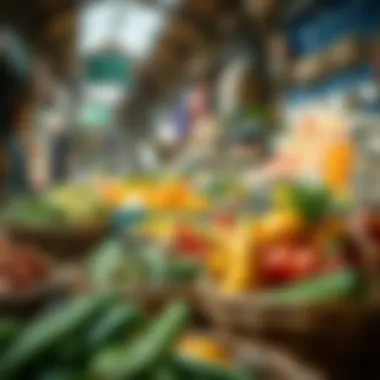
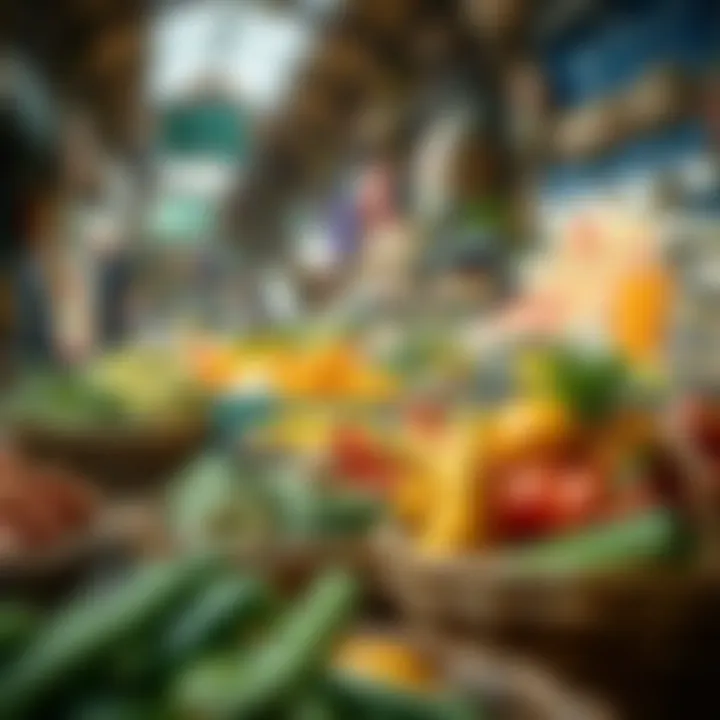
Adaptation to Modern Commerce
Souks are increasingly merging their age-old practices with modern business strategies. Vendors, recognizing the changing consumer landscape, have started to adopt digital payment methods and online marketing to attract tech-savvy shoppers. Many traditional sellers now showcase their goods on social media platforms like Facebook and Instagram, allowing them to reach broader audiences without losing the authenticity of their offerings.
Moreover, some souks have initiated collaborations with local artisans and entrepreneurs. This not only boosts their visibility but also promotes grassroots industry, enhancing the cultural fabric woven into these markets. For instance, in Marrakech, the Souk Semmarine blends craftsmanship with contemporary design, creating a distinctive experience that honors its heritage while appealing to modern sensibilities.
Through these adaptations, souks are not just retaining their customer base; they are fostering an innovative ecosystem where tradition meets modernity.
Impact of Globalization
Globalization is a double-edged sword for traditional souks. On one hand, it presents challenges from large retail chains and e-commerce giants that threaten to overshadow local markets. However, on the other hand, it also opens new avenues for souks to flourish by facilitating cross-cultural interactions and expanding their reach.
As international tourism grows, souks are becoming key destinations for visitors seeking authentic local experiences. This influx of travelers creates opportunities for artisans to showcase their crafts, which, in turn, helps preserve traditional skills. For example, the Grand Bazaar in Istanbul, a historic trading hub, draws millions of tourists each year whose interest in local goods ensures that traditional artisans remain viable.
Yet, the impact of globalization isn’t solely positive. Many traditional vendors voice concerns over rising rents and competition from foreign brands. To combat this, initiatives focused on promoting local brands and sustainable practices are gaining traction. Consumers, now more mindful of their purchasing choices, are increasingly drawn to unique, ethically produced items.
The Future of Traditional Markets
As the world continues to evolve, traditional markets, or souks, face a significant crossroads. The future of these bustling hubs of commerce is not just about survival; it’s about transformation. They are at a critical juncture where adapting to modernity while preserving their cultural essence becomes essential. The significance of this topic lies in understanding how these markets can continue to thrive in an increasingly digital and globalized society.
The importance of traditional souks in maintaining community ties, local economies, and cultural heritage cannot be overstated. Investors, homebuyers, realtors, expatriates, and developers ought to keep a keen eye on how the future unfolds. Questions arise: How can these markets be sustainable? What role does technology play? The answers can illuminate paths toward a more vibrant community-centric commerce.
Sustainability Efforts
Sustainability is more than just a buzzword; it's a fundamental need for the future of traditional markets. As consumers become more environmentally conscious, souks have a unique opportunity to embrace eco-friendly practices. These might include:
- Use of Local Resources: Sourcing goods locally reduces carbon footprints and supports local artisans. This practice not only enhances authenticity but also fosters a sense of pride among local communities.
- Waste Reduction: Implementing recycling programs and reducing plastic usage can significantly contribute to an environmentally friendly market. Initiatives could involve encouraging vendors to use biodegradable packaging or repurposing materials in creative ways.
- Support for Organic Products: Farmers' markets within souks can promote organic farming, thereby attracting health-conscious buyers and elevating the market's reputation.
Such sustainability efforts resonate well with consumers who increasingly prioritize ethical and eco-conscious choices in their purchases. As these markets adopt more sustainable methods, they're likely to see increased foot traffic and customer loyalty. This is a pivotal time for communities to bond over their shared commitment to a greener future.
Innovation and Technology Integration
While it might seem counterintuitive, traditional markets must also embrace innovation to remain relevant. Here’s how tech integration can reshape the souk experience:
- Digital Payment Options: With credit cards and mobile payment apps sweeping across the globe, offering digital payment solutions can attract a younger crowd accustomed to cashless transactions.
- Virtual Tours: Developing virtual shopping experiences for those unable to visit souks physically can broaden the market’s reach. This could involve online platforms that highlight products and artisans, enabling them to showcase their crafts to a global audience.
- Social Media Marketing: Vendors can use platforms like Facebook and Instagram to promote their goods, share stories, and create a community around their products. By sharing high-quality images and engaging videos, souks can attract a wider audience.
- Smart Technology: Implementing smart kiosks featuring digital maps and vendor information can enhance the navigability of markets, ensuring visitors find exactly what they seek without the frustration of getting lost.
Incorporating such innovations not only makes the shopping experience smooth and enjoyable but also enriches the connection between the consumer and the creator. This blend of tradition and modernity is where the charm of souks truly lies.
"The essence of traditional markets lies in their ability to adapt, survive, and thrive amid change."
The blend of sustainability and technological innovation presents a brighter future for traditional markets. By addressing these facets, souks can continue being the lifeblood of their communities while holding onto their rich cultural heritage.
Epilogue: The Enduring Legacy of Souks
Exploring the traditional souks reveals not just a marketplace but a vibrant part of the cultural and communal fabric in many regions. From their historical roots to their current functionalities, these markets showcase a blend of old-world charm and adaptability. Understanding the significance of souks is essential for anyone interested in the dynamics of local commerce and community engagement. This guide has illuminated several facets of souks, thereby enhancing our appreciation of these locales.
Summation of Key Points
In revisiting the core elements discussed throughout the article, we can outline the following key points:
- Historical Significance: Souks are deeply rooted in history, serving as centers for trade and interaction long before modern shopping centers emerged.
- Cultural Identity: These markets are a reflection of cultural heritage; they embody traditions, crafts, and culinary delights that define communities.
- Economic Contributions: Souks play an essential role in stimulating local economies. They support small businesses and provide livelihood opportunities for many entrepreneurs.
- Navigational Aspects: Engaging with a souk involves understanding their layout, bargaining practices, and the atmosphere that fosters social connections.
- Adaptability and Future Prospects: Despite the pressures of globalization and modernization, souks have shown remarkable resilience, adapting their practices while retaining their essence.
Final Thoughts on Future Developments
As we cast our eyes towards the future, the narrative of souks is likely to evolve. They are not just relics of the past; rather, they are evolving entities responding to contemporary challenges. Here are a few considerations for what lies ahead:
- Sustainability Initiatives: The future of souks may involve more sustainable practices. As communities become increasingly aware of ecological impacts, souks might incorporate eco-friendly products and promote local, organic goods, providing a green alternative to mass-produced items.
- Integration of Technology: The introduction of technology, such as online platforms and digital payments, could further enhance the shopping experience and broaden the market reach, allowing souks to attract not just locals but also international customers.
- Cultural Showcase: Souks have an opportunity to become cultural ambassors, showcasing local artisanship and heritage through events, workshops, and collaborations with artists, thereby preserving traditions by making them relevant to younger generations.
"Markets are the heartbeats of communities. When they thrive, the community thrives." - Anonymous
For further exploration into the significance of markets in culture and economy, consider these resources:















